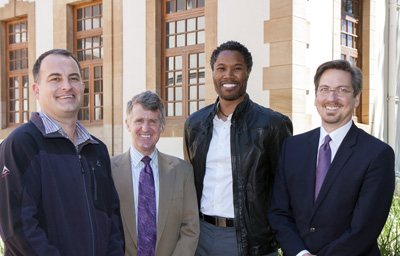
From the left are: Prof Francois Strydom (Director: Academic - Centre for Teaching and Learning at the UFS), Mr Rip Rapson (Chief Executive Officer, Kresge Foundation), Dr Marcus Ingram (UFS Director for Institutional Advancement) and Mr Bill Moses (Programme Director for the Kresge Foundation's Education Programme).
Photo: Hannes Pieterse |
The Kresge Foundation has awarded $400 000 (about R4 million) to the University of the Free State (UFS) to increase student success through improved data analysis.
This four-year grant, as part of Kresge’s Siyaphumelela initiative, was recently announced by Mr Rip Rapson, Kresge’s President and Chief Executive Officer. This announcement was made at a symposium on South African higher education and philanthropy in Cape Town.
“Universities across South Africa are grappling with how to improve persistence and graduation rates for their black students in particular,” Mr Rapson said. “These universities will work together with the South African Institute for Distance Education to develop their data analytics capacity to find and share solutions and interventions based on solid information to improve student success.”
The UFS was only one of four universities receiving funding from Kresge. The other universities include the Nelson Mandela metropolitan University in Port Elizabeth, the University of the Witwatersrand in Johannesburg and the University of Pretoria.
The grants will help the universities build their capacities to use data to better integrate institutional research, information communication technology, academic development, student services and academic departments. Beyond the improvements sought for the UFS, Kresge hopes to see new approaches to data become mainstream for higher education in South Africa.
The Siyaphumelela initiative provides four years of institutional support and hope to create a community of practice that learns lessons that may benefit not only individual institutions and the cohort, but also potentially all of South African higher education.
Dr Lis Lange, Vice-Rector: Academic at the UFS, said improving student successes is a university goal that operates in the interface between the Human and Academic Projects of the university.
“We are delighted to be part of an initiative that is going to help us develop greater capability for data analytics and deeper integration between data and teaching and learning practices; and, at the same time, will bring the Centre for Teaching and Learning, the Directorate for Institutional Research and Academic Planning (DIRAP) and the faculties into a closer cooperation.”
Over the past four years donor income to the UFS increased considerably, both from governmental sources, trusts and foundations. By the end of 2013, governmental funding increased from about R5 million in 2011 to over R35 million. Funding by trusts and foundations increased from R5 million in 2011 to over R15 million in 2013. A general increase of 25% in funding is expected for 2014.
Dr Marcus Ingram, UFS Director for Institutional Advancement, says as the UFS begins to settle into a refined academic identity, the Department for Institutional Advancement intends to support these efforts by helping to facilitate the telling of a more integrated narrative to the university’s friends, prospects and donors.